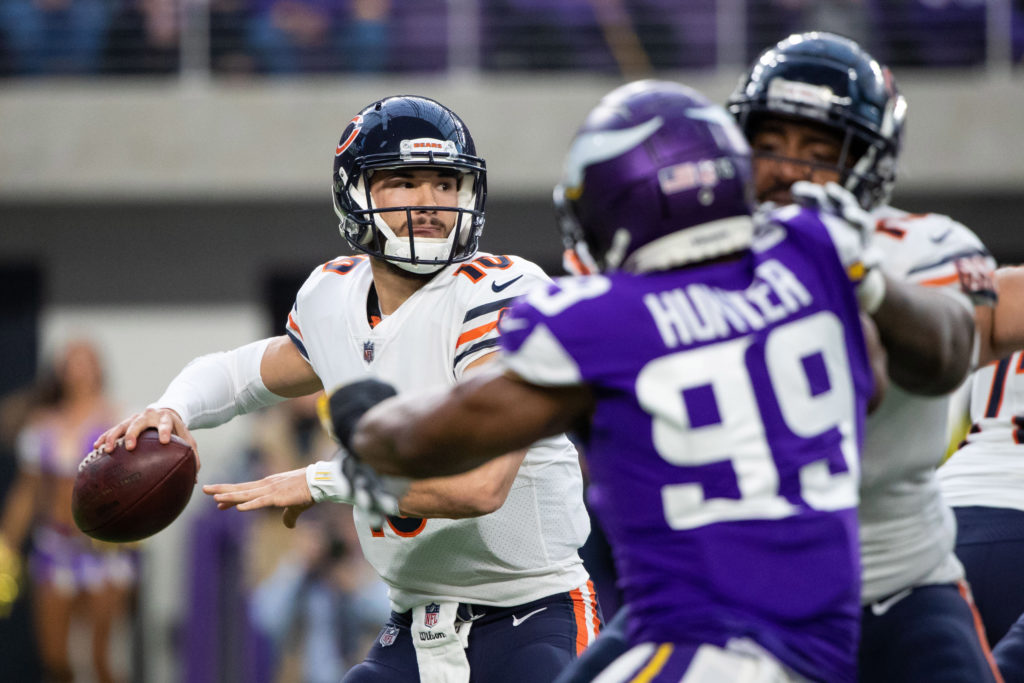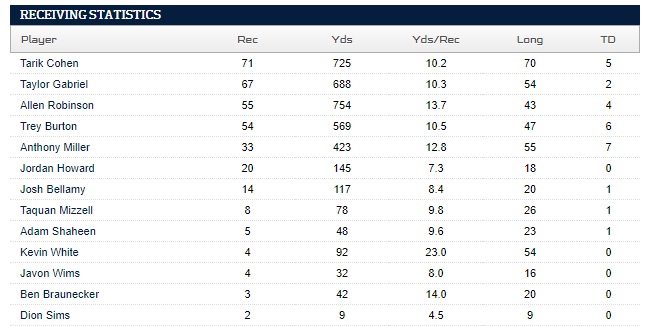Ad Disclosure
Wild Card Weekend: A Look at Chicago’s Offense

Let’s get it back to the Eagles.
We’ve got a playoff game to talk about, and it looks good on paper.
This is a Chicago team that hasn’t been to the postseason in eight years. The quarterback has never played in a playoff game and Matt Nagy is a first-year head coach who is entering relatively unfamiliar territory, at least in his current role. The Bears play host to an experienced and battle-tested Philly team on a three-game winning streak that thrives in the underdog role. All of the intangible stuff surrounding this game seems to favor the Eagles, who should feel little to no pressure on Sunday afternoon.
But they don’t play the games on paper, so here’s a short scoop on the Chicago offense.
Numbers
I like to start it off with a general overview of how the opponent performed statistically.
Here are Da Bears regular season marks:
- 21st in total offense (343 yards per game)
- 21st in passing offense (222 YPG)
- 11th in rushing offense (121 YPG)
- 9th in points per game (23)
- 11th in 3rd down conversion rate (41%)
- 11th in 4th down conversion rate (60% on a 9-15 mark)
- 8th best in penalties committed (just 97 total, six per game)
- 16th in first downs (331 total, 20.6 per game)
- 27th in rush yards per attempt (4.1)
- tied for 7th in rushing touchdowns (16)
- 12th in passing touchdowns (28)
- 14 interceptions thrown (12th most in NFL)
- 9 fumbles lost (4th most)
- 36 takeaways (#1), 24 giveaways (#8) for a +12 turnover margin
- average time of possession 31:59 (3rd, just behind Eagles)
Those are their league-wide totals. You see they aren’t an amazing passing team, but they do a really nice job of controlling the clock and moving the chains with a rushing offense that finished just outside of the top-ten. They really are similar to the Eagles in the way they limit penalties and win in auxiliary areas of the game, though that positive turnover margin is much more about their defense and not their offense. They’ve coughed the ball up rather frequently this season.
Here are their individual numbers on the season, after the jump:
Nothing amazing from Trubisky in the passing game. He was middle of the road in just about every single category this year.
Howard had a nice season running the ball, but that 3.7 yards per attempt number was very low for a 1st choice RB, ranked all the way down at 39th in the NFL next to guys like Peyton Barber and Alfred Morris. Tarik Cohen fared better in that category, but you may recall the Eagles absolutely demolished Chicago in the running game last season, holding the duo to nine carries for -5 yards. It was an absurd performance by the defensive line, and Trubisky, who does a lot of good things with his feet, only carried it four times for 12 yards at Lincoln Financial Field as a rookie.
He’s not Lamar Jackson, but he did finish sixth in rushing yards among NFL quarterbacks this season, which is a key to their success in moving the chains.
Here are the receiver stats:
The receiving corps is solid but nothing to write home about. There’s nobody out there who really makes you say, “oh shit, who’s gonna cover that guy?” There’s no fantasy football stud. Gabriel was an Atlanta castoff who can stretch the field a bit. Allen Robinson did a decent job this season coming off a 2017 ACL tear. Trey Burton had some nice moments as well, but what Chicago does best in the passing game is kill teams out of the backfield with Cohen, who does a lot of moving around in various formations.
It’s on the Eagles defense to limit him and limit Howard and force Trubisky to pass his way to victory. Both teams are pretty similar in the way they control the clock and limit opponents via stout run defense, so I think if the Eagles put the game on Trubisky’s shoulders, then they’re going to be in good shape.
Clips and quotes and stuff
By know you know that Nagy comes from the Andy Reid coaching tree. He spent a brief amount of time in Philadelphia as an intern, assistant, and then a quality control guy on the offensive side of the ball. He followed Andy to Kansas City and he incorporates some of those concepts into what Chicago does now.
Jim Schwartz was asked about that this week, the idea that the Bears do some similar things in the offensive game:
“It’s different when it comes to what his players are, all the different things that are going on in the NFL. I think that’s a sign of good coaching. I think that’s probably No. 1. But I do think that even though you’re seeing a completely different scheme, you’re seeing some core things — I don’t know another way to put it.
Still efficient running the ball, and a short passing game was still very important to them. I think those things carry over. They might do it a completely different way. Nobody was running zone read in 1999 (Andy Reid’s first year). Everybody was running true west coast things, but the principles of run the ball still, control the game with the run, they do a very good job of that.
High percentage passing game. Might look a little bit different, but there are different ways that they do it.”
And then a follow-up question about Andy always having a smaller guy, a scat back or good pass-catching tailback like Brian Westbrook or Tyreek Hill, guys who are similar to Tarik Cohen:
Schwartz:
“I don’t know that he was using them as wide receivers back then. But, yeah, for sure. It’s just a different way to do a lot of the same things. No matter how far you go to all the different ways offenses are working right now, running the ball still works. Running the ball is still important. Short passing game, high percentage, keeping the sticks moving, is still important. Making big plays, still important. Mobility of a quarterback, still important.
All these things carry over. It’s packaged up a little different, it looks a little bit different, but those core principles stay the same.”
A couple of clips chained together here to show those concepts –
In the first play, you’ll see some pre-snap motion to get Cohen free in the flat. In the second play, they get some lost yards back with a short completion to Howard. On the third play, Trubisky moves the chains with his feet:
LA does a really nice job on those first two plays, but you see how Trubisky has a good feel for when to step up in the pocket and just take off running. He’s got a good internal clock, a good sense of when pressure is coming.
Here’s Schwartz on Trubisky’s running ability:
First of all, it’s part of the run game, so I think that’s the No. 1 part. He’s certainly capable of pulling the ball and running for yards and first downs and things like that. It just adds another dynamic to the passing game.
We’ve seen it from so many different quarterbacks. If it’s not there, he can create and start a new play. He can also make a big play down the field. I think we saw that a little bit from him last year. I know in that game we were having a really good run defense game in that game, and he had a scramble late in that game that sort of took them out of the negative yards.
So we saw him move around a bunch. That’s part of what they do, and it’s been working for them. We’re going to have to do a good job keeping him contained, reading our keys, making sure we’re playing responsibility when it comes to the zone read and the RPOs and those things because if you don’t, he’s a guy that can make you look bad.
There are also a lot of instances where Trubisky is willing to throw short and take what the defense gives him.
On a play like this, they’ll run just a little bit of pre-snap motion, pull Cohen in, then roll him back out on a short route. Richard Sherman is willing to give up the underneath yards to prevent a deep toss instead:
That’s not dissimilar from the wheel route or that little out that the Eagles use successfully with Darren Sproles. In this case, San Francisco was willing to concede the short pass on 2nd and 4.
Schwartz with more on Chicago’s penchant for moving guys around at the line of scrimmage:
People use motion a lot of different ways. They use motion to ID defenses. They use motion to put stress on defenses from like having to cover a guy when he’s running as fast as he can away from you. They use those kind of motions to make you have to communicate, make guys have to change responsibilities across the way.
….
It’s nothing we haven’t seen from half a dozen teams this year. They’re not doing anything unique. They just have really good players doing it and they do a nice job in their scheme of putting you in positions that you have to communicate, and you also have to watch your keys. You can’t get distracted by other things.
More or less.
Chicago has a different coaching staff this year, so even though a lot of the personnel is similar, the scheme is not, and you weren’t getting as much of the Kansas City and LA Rams influence when the Bears played at Lincoln Financial Field in 2017. Schwartz described their offense as a “melting pot” and referred to Trubisky as a “point guard” type of quarterback who successfully navigates zone reads, various RPO looks, and those quick slants and hitches and speed-outs. You’ll also see jet sweeps and end-arounds from guys like Gabriel and rookie Anthony Miller, who leads the team with 7 receiving touchdowns but dislocated his left shoulder in week 17 and will not be 100% healthy if he’s on the field Sunday. Gabriel is also dealing with bruised ribs.
That’s about it. Chicago’s overall success this season can be credited to their incredibly stout defense, but the offense does some nice things and has a couple of tricky playmakers that need to be accounted for.
The Eagles win if they:
- stuff Jordan Howard in the run game
- limit third down scrambles and chunk yardage ground pickups for Trubisky
- keep Cohen in front of them, communicate, and stay disciplined with pre-snap motion and some quirky receiver-involved plays
Mitch Trubisky is a second-year quarterback heading into his first playoff game. I don’t think he wins the game if he’s forced to throw his way to victory, so the game plan here should be relatively straightforward. This should be a very low-scoring game, maybe 13-10 or 17-14, something in that range.
Kevin has been writing about Philadelphia sports since 2009. He spent seven years in the CBS 3 sports department and started with the Union during the team's 2010 inaugural season. He went to the academic powerhouses of Boyertown High School and West Virginia University. email - k.kinkead@sportradar.com

